Business Finance: Performance, Ratios & Economic Analysis - XYZ Plc
VerifiedAdded on 2023/06/11
|10
|3124
|413
Report
AI Summary
This report provides a comprehensive analysis of business finance and economics, focusing on the drivers of business performance and the distinction between macro and micro economics. It explains the function and significance of accounting in corporate decision-making, detailing various types of financial statements and relevant terminology. The report includes a calculation and interpretation of financial ratios for XYZ Plc for the years 2019 and 2020, covering operating profit margin, gross profit margin, current ratio, acid test ratio, and earnings per share. Furthermore, it defines management accounting and highlights its significance in assisting superior management in making financial choices and directing the company's daily operations. The analysis covers market competition, technological development, consumers, suppliers, and creditors as key factors influencing business performance.

Business Finance and
Economics
Economics
Paraphrase This Document
Need a fresh take? Get an instant paraphrase of this document with our AI Paraphraser
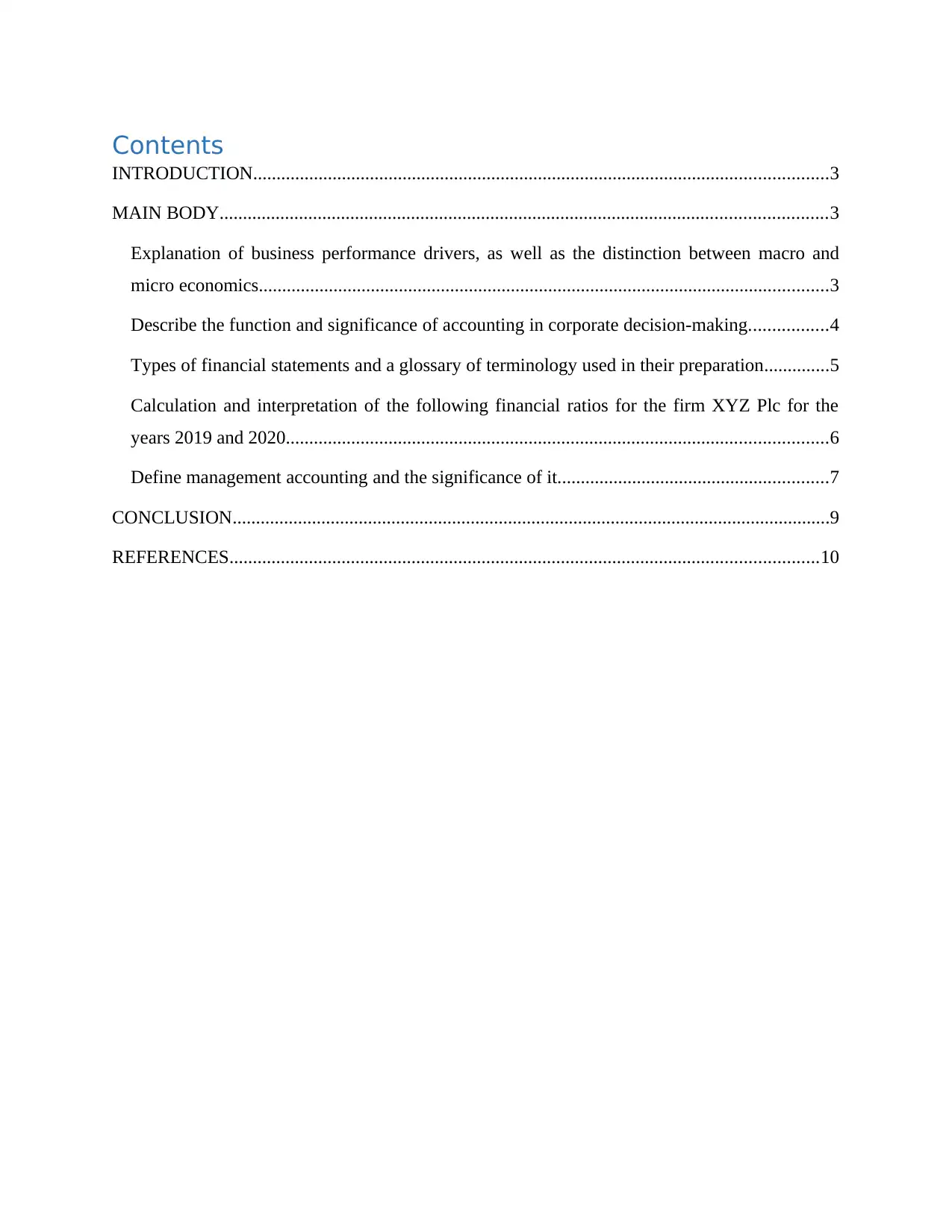
Contents
INTRODUCTION...........................................................................................................................3
MAIN BODY..................................................................................................................................3
Explanation of business performance drivers, as well as the distinction between macro and
micro economics..........................................................................................................................3
Describe the function and significance of accounting in corporate decision-making.................4
Types of financial statements and a glossary of terminology used in their preparation..............5
Calculation and interpretation of the following financial ratios for the firm XYZ Plc for the
years 2019 and 2020....................................................................................................................6
Define management accounting and the significance of it..........................................................7
CONCLUSION................................................................................................................................9
REFERENCES..............................................................................................................................10
INTRODUCTION...........................................................................................................................3
MAIN BODY..................................................................................................................................3
Explanation of business performance drivers, as well as the distinction between macro and
micro economics..........................................................................................................................3
Describe the function and significance of accounting in corporate decision-making.................4
Types of financial statements and a glossary of terminology used in their preparation..............5
Calculation and interpretation of the following financial ratios for the firm XYZ Plc for the
years 2019 and 2020....................................................................................................................6
Define management accounting and the significance of it..........................................................7
CONCLUSION................................................................................................................................9
REFERENCES..............................................................................................................................10
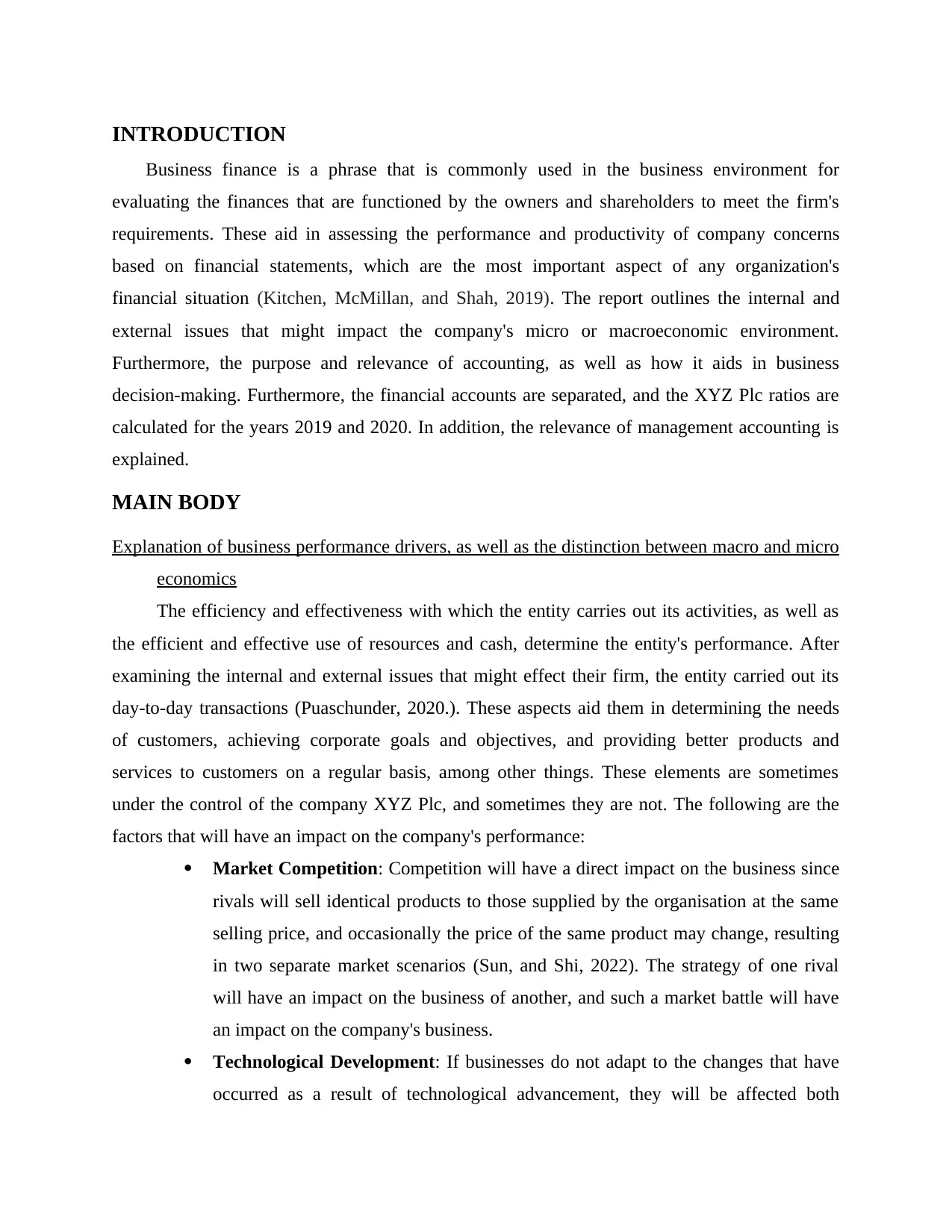
INTRODUCTION
Business finance is a phrase that is commonly used in the business environment for
evaluating the finances that are functioned by the owners and shareholders to meet the firm's
requirements. These aid in assessing the performance and productivity of company concerns
based on financial statements, which are the most important aspect of any organization's
financial situation (Kitchen, McMillan, and Shah, 2019). The report outlines the internal and
external issues that might impact the company's micro or macroeconomic environment.
Furthermore, the purpose and relevance of accounting, as well as how it aids in business
decision-making. Furthermore, the financial accounts are separated, and the XYZ Plc ratios are
calculated for the years 2019 and 2020. In addition, the relevance of management accounting is
explained.
MAIN BODY
Explanation of business performance drivers, as well as the distinction between macro and micro
economics
The efficiency and effectiveness with which the entity carries out its activities, as well as
the efficient and effective use of resources and cash, determine the entity's performance. After
examining the internal and external issues that might effect their firm, the entity carried out its
day-to-day transactions (Puaschunder, 2020.). These aspects aid them in determining the needs
of customers, achieving corporate goals and objectives, and providing better products and
services to customers on a regular basis, among other things. These elements are sometimes
under the control of the company XYZ Plc, and sometimes they are not. The following are the
factors that will have an impact on the company's performance:
Market Competition: Competition will have a direct impact on the business since
rivals will sell identical products to those supplied by the organisation at the same
selling price, and occasionally the price of the same product may change, resulting
in two separate market scenarios (Sun, and Shi, 2022). The strategy of one rival
will have an impact on the business of another, and such a market battle will have
an impact on the company's business.
Technological Development: If businesses do not adapt to the changes that have
occurred as a result of technological advancement, they will be affected both
Business finance is a phrase that is commonly used in the business environment for
evaluating the finances that are functioned by the owners and shareholders to meet the firm's
requirements. These aid in assessing the performance and productivity of company concerns
based on financial statements, which are the most important aspect of any organization's
financial situation (Kitchen, McMillan, and Shah, 2019). The report outlines the internal and
external issues that might impact the company's micro or macroeconomic environment.
Furthermore, the purpose and relevance of accounting, as well as how it aids in business
decision-making. Furthermore, the financial accounts are separated, and the XYZ Plc ratios are
calculated for the years 2019 and 2020. In addition, the relevance of management accounting is
explained.
MAIN BODY
Explanation of business performance drivers, as well as the distinction between macro and micro
economics
The efficiency and effectiveness with which the entity carries out its activities, as well as
the efficient and effective use of resources and cash, determine the entity's performance. After
examining the internal and external issues that might effect their firm, the entity carried out its
day-to-day transactions (Puaschunder, 2020.). These aspects aid them in determining the needs
of customers, achieving corporate goals and objectives, and providing better products and
services to customers on a regular basis, among other things. These elements are sometimes
under the control of the company XYZ Plc, and sometimes they are not. The following are the
factors that will have an impact on the company's performance:
Market Competition: Competition will have a direct impact on the business since
rivals will sell identical products to those supplied by the organisation at the same
selling price, and occasionally the price of the same product may change, resulting
in two separate market scenarios (Sun, and Shi, 2022). The strategy of one rival
will have an impact on the business of another, and such a market battle will have
an impact on the company's business.
Technological Development: If businesses do not adapt to the changes that have
occurred as a result of technological advancement, they will be affected both
⊘ This is a preview!⊘
Do you want full access?
Subscribe today to unlock all pages.

Trusted by 1+ million students worldwide
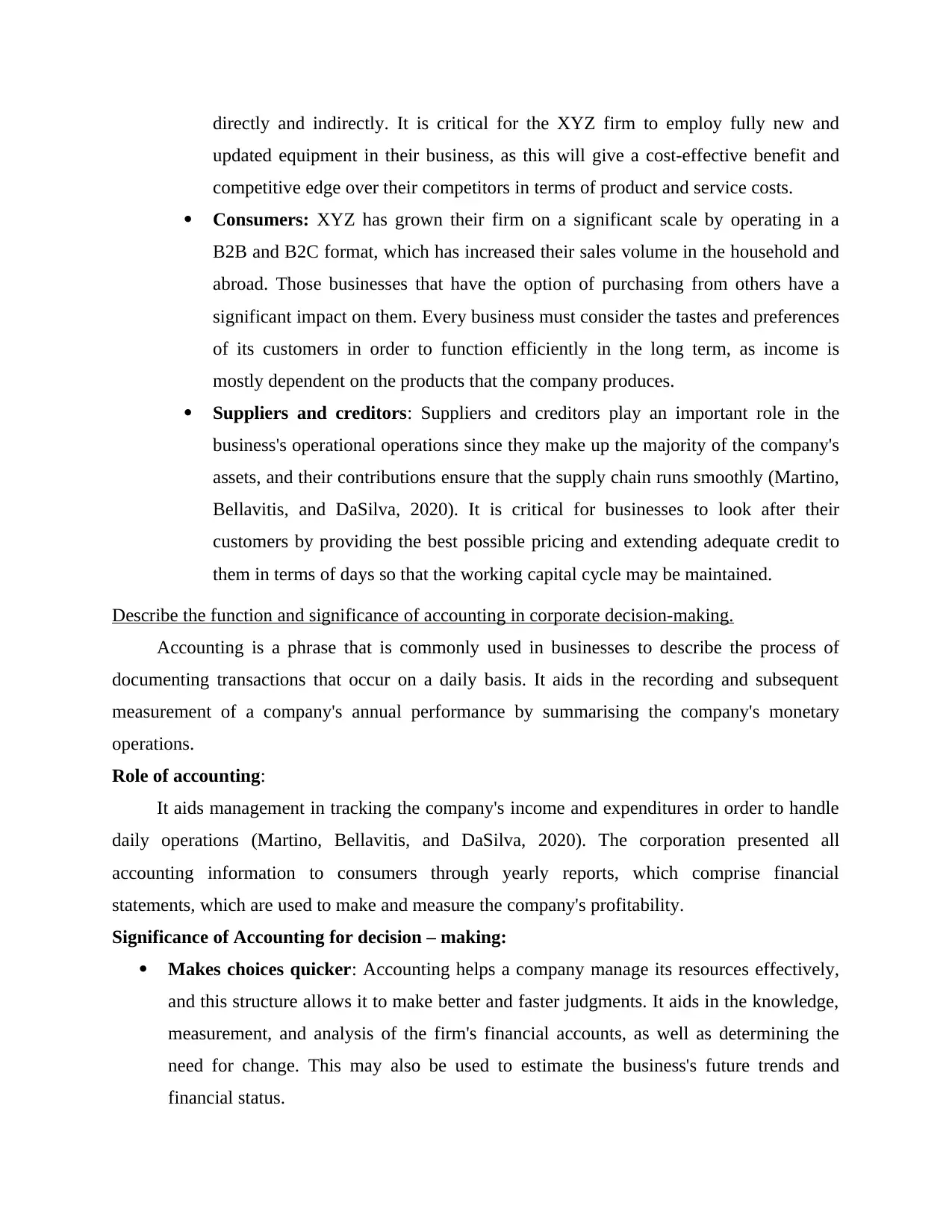
directly and indirectly. It is critical for the XYZ firm to employ fully new and
updated equipment in their business, as this will give a cost-effective benefit and
competitive edge over their competitors in terms of product and service costs.
Consumers: XYZ has grown their firm on a significant scale by operating in a
B2B and B2C format, which has increased their sales volume in the household and
abroad. Those businesses that have the option of purchasing from others have a
significant impact on them. Every business must consider the tastes and preferences
of its customers in order to function efficiently in the long term, as income is
mostly dependent on the products that the company produces.
Suppliers and creditors: Suppliers and creditors play an important role in the
business's operational operations since they make up the majority of the company's
assets, and their contributions ensure that the supply chain runs smoothly (Martino,
Bellavitis, and DaSilva, 2020). It is critical for businesses to look after their
customers by providing the best possible pricing and extending adequate credit to
them in terms of days so that the working capital cycle may be maintained.
Describe the function and significance of accounting in corporate decision-making.
Accounting is a phrase that is commonly used in businesses to describe the process of
documenting transactions that occur on a daily basis. It aids in the recording and subsequent
measurement of a company's annual performance by summarising the company's monetary
operations.
Role of accounting:
It aids management in tracking the company's income and expenditures in order to handle
daily operations (Martino, Bellavitis, and DaSilva, 2020). The corporation presented all
accounting information to consumers through yearly reports, which comprise financial
statements, which are used to make and measure the company's profitability.
Significance of Accounting for decision – making:
Makes choices quicker: Accounting helps a company manage its resources effectively,
and this structure allows it to make better and faster judgments. It aids in the knowledge,
measurement, and analysis of the firm's financial accounts, as well as determining the
need for change. This may also be used to estimate the business's future trends and
financial status.
updated equipment in their business, as this will give a cost-effective benefit and
competitive edge over their competitors in terms of product and service costs.
Consumers: XYZ has grown their firm on a significant scale by operating in a
B2B and B2C format, which has increased their sales volume in the household and
abroad. Those businesses that have the option of purchasing from others have a
significant impact on them. Every business must consider the tastes and preferences
of its customers in order to function efficiently in the long term, as income is
mostly dependent on the products that the company produces.
Suppliers and creditors: Suppliers and creditors play an important role in the
business's operational operations since they make up the majority of the company's
assets, and their contributions ensure that the supply chain runs smoothly (Martino,
Bellavitis, and DaSilva, 2020). It is critical for businesses to look after their
customers by providing the best possible pricing and extending adequate credit to
them in terms of days so that the working capital cycle may be maintained.
Describe the function and significance of accounting in corporate decision-making.
Accounting is a phrase that is commonly used in businesses to describe the process of
documenting transactions that occur on a daily basis. It aids in the recording and subsequent
measurement of a company's annual performance by summarising the company's monetary
operations.
Role of accounting:
It aids management in tracking the company's income and expenditures in order to handle
daily operations (Martino, Bellavitis, and DaSilva, 2020). The corporation presented all
accounting information to consumers through yearly reports, which comprise financial
statements, which are used to make and measure the company's profitability.
Significance of Accounting for decision – making:
Makes choices quicker: Accounting helps a company manage its resources effectively,
and this structure allows it to make better and faster judgments. It aids in the knowledge,
measurement, and analysis of the firm's financial accounts, as well as determining the
need for change. This may also be used to estimate the business's future trends and
financial status.
Paraphrase This Document
Need a fresh take? Get an instant paraphrase of this document with our AI Paraphraser
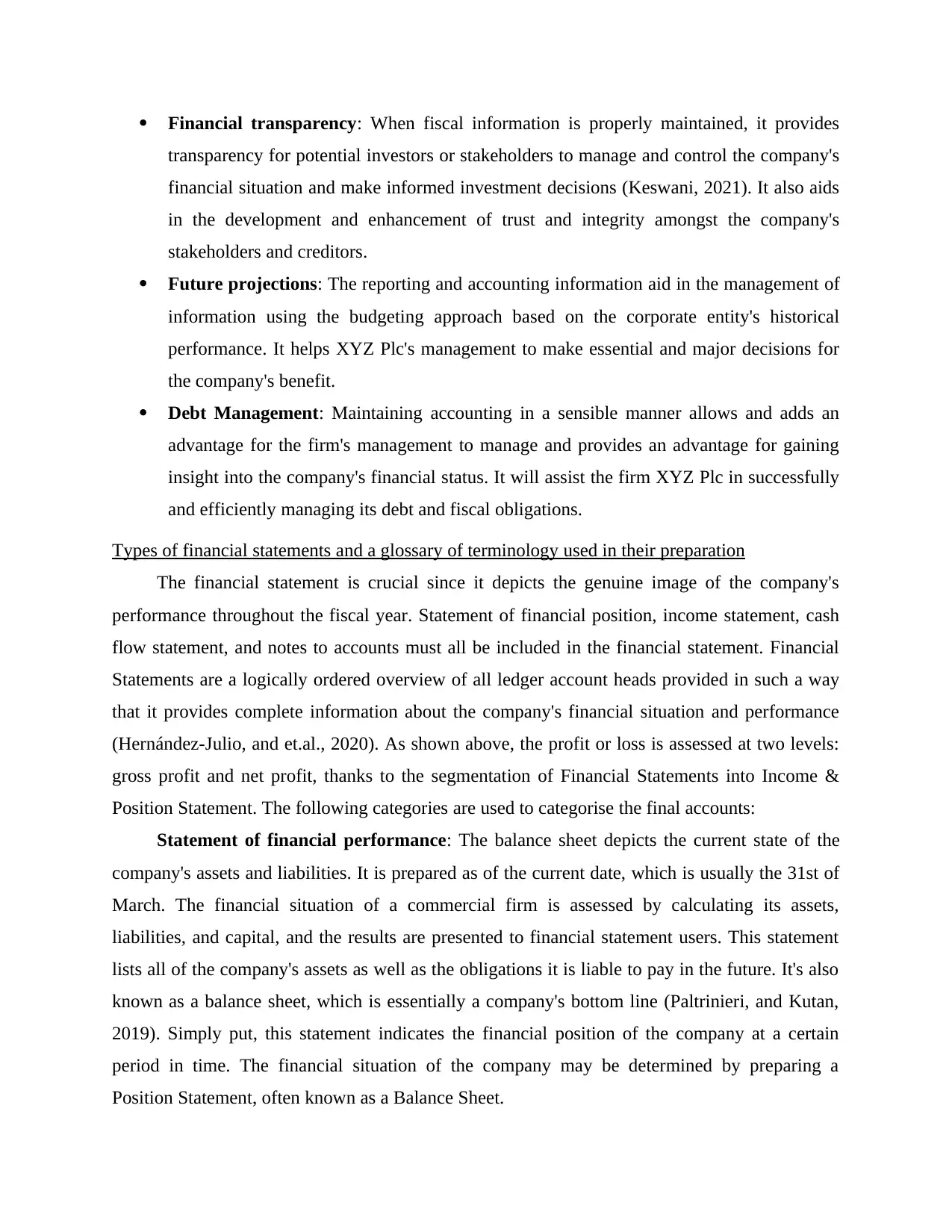
Financial transparency: When fiscal information is properly maintained, it provides
transparency for potential investors or stakeholders to manage and control the company's
financial situation and make informed investment decisions (Keswani, 2021). It also aids
in the development and enhancement of trust and integrity amongst the company's
stakeholders and creditors.
Future projections: The reporting and accounting information aid in the management of
information using the budgeting approach based on the corporate entity's historical
performance. It helps XYZ Plc's management to make essential and major decisions for
the company's benefit.
Debt Management: Maintaining accounting in a sensible manner allows and adds an
advantage for the firm's management to manage and provides an advantage for gaining
insight into the company's financial status. It will assist the firm XYZ Plc in successfully
and efficiently managing its debt and fiscal obligations.
Types of financial statements and a glossary of terminology used in their preparation
The financial statement is crucial since it depicts the genuine image of the company's
performance throughout the fiscal year. Statement of financial position, income statement, cash
flow statement, and notes to accounts must all be included in the financial statement. Financial
Statements are a logically ordered overview of all ledger account heads provided in such a way
that it provides complete information about the company's financial situation and performance
(Hernández-Julio, and et.al., 2020). As shown above, the profit or loss is assessed at two levels:
gross profit and net profit, thanks to the segmentation of Financial Statements into Income &
Position Statement. The following categories are used to categorise the final accounts:
Statement of financial performance: The balance sheet depicts the current state of the
company's assets and liabilities. It is prepared as of the current date, which is usually the 31st of
March. The financial situation of a commercial firm is assessed by calculating its assets,
liabilities, and capital, and the results are presented to financial statement users. This statement
lists all of the company's assets as well as the obligations it is liable to pay in the future. It's also
known as a balance sheet, which is essentially a company's bottom line (Paltrinieri, and Kutan,
2019). Simply put, this statement indicates the financial position of the company at a certain
period in time. The financial situation of the company may be determined by preparing a
Position Statement, often known as a Balance Sheet.
transparency for potential investors or stakeholders to manage and control the company's
financial situation and make informed investment decisions (Keswani, 2021). It also aids
in the development and enhancement of trust and integrity amongst the company's
stakeholders and creditors.
Future projections: The reporting and accounting information aid in the management of
information using the budgeting approach based on the corporate entity's historical
performance. It helps XYZ Plc's management to make essential and major decisions for
the company's benefit.
Debt Management: Maintaining accounting in a sensible manner allows and adds an
advantage for the firm's management to manage and provides an advantage for gaining
insight into the company's financial status. It will assist the firm XYZ Plc in successfully
and efficiently managing its debt and fiscal obligations.
Types of financial statements and a glossary of terminology used in their preparation
The financial statement is crucial since it depicts the genuine image of the company's
performance throughout the fiscal year. Statement of financial position, income statement, cash
flow statement, and notes to accounts must all be included in the financial statement. Financial
Statements are a logically ordered overview of all ledger account heads provided in such a way
that it provides complete information about the company's financial situation and performance
(Hernández-Julio, and et.al., 2020). As shown above, the profit or loss is assessed at two levels:
gross profit and net profit, thanks to the segmentation of Financial Statements into Income &
Position Statement. The following categories are used to categorise the final accounts:
Statement of financial performance: The balance sheet depicts the current state of the
company's assets and liabilities. It is prepared as of the current date, which is usually the 31st of
March. The financial situation of a commercial firm is assessed by calculating its assets,
liabilities, and capital, and the results are presented to financial statement users. This statement
lists all of the company's assets as well as the obligations it is liable to pay in the future. It's also
known as a balance sheet, which is essentially a company's bottom line (Paltrinieri, and Kutan,
2019). Simply put, this statement indicates the financial position of the company at a certain
period in time. The financial situation of the company may be determined by preparing a
Position Statement, often known as a Balance Sheet.
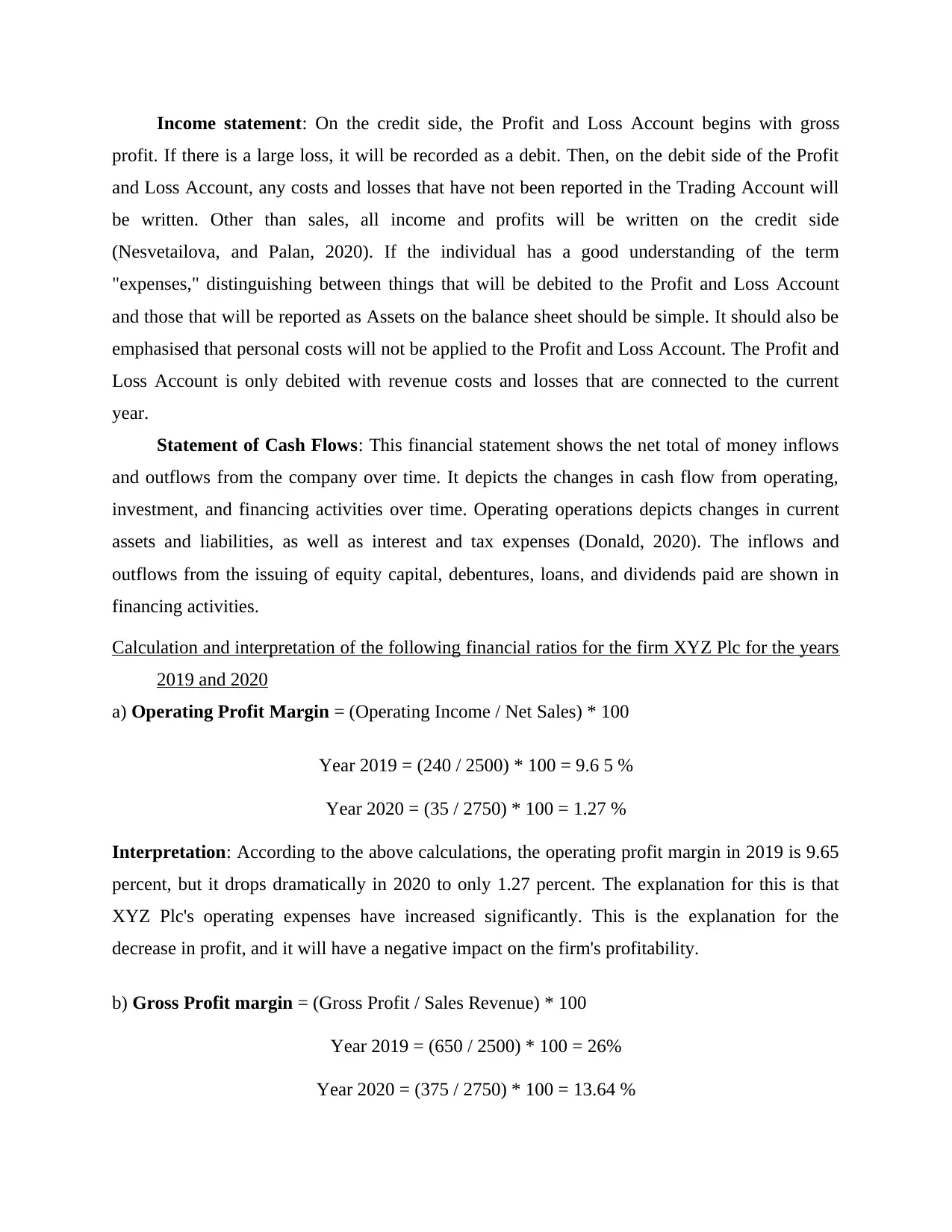
Income statement: On the credit side, the Profit and Loss Account begins with gross
profit. If there is a large loss, it will be recorded as a debit. Then, on the debit side of the Profit
and Loss Account, any costs and losses that have not been reported in the Trading Account will
be written. Other than sales, all income and profits will be written on the credit side
(Nesvetailova, and Palan, 2020). If the individual has a good understanding of the term
"expenses," distinguishing between things that will be debited to the Profit and Loss Account
and those that will be reported as Assets on the balance sheet should be simple. It should also be
emphasised that personal costs will not be applied to the Profit and Loss Account. The Profit and
Loss Account is only debited with revenue costs and losses that are connected to the current
year.
Statement of Cash Flows: This financial statement shows the net total of money inflows
and outflows from the company over time. It depicts the changes in cash flow from operating,
investment, and financing activities over time. Operating operations depicts changes in current
assets and liabilities, as well as interest and tax expenses (Donald, 2020). The inflows and
outflows from the issuing of equity capital, debentures, loans, and dividends paid are shown in
financing activities.
Calculation and interpretation of the following financial ratios for the firm XYZ Plc for the years
2019 and 2020
a) Operating Profit Margin = (Operating Income / Net Sales) * 100
Year 2019 = (240 / 2500) * 100 = 9.6 5 %
Year 2020 = (35 / 2750) * 100 = 1.27 %
Interpretation: According to the above calculations, the operating profit margin in 2019 is 9.65
percent, but it drops dramatically in 2020 to only 1.27 percent. The explanation for this is that
XYZ Plc's operating expenses have increased significantly. This is the explanation for the
decrease in profit, and it will have a negative impact on the firm's profitability.
b) Gross Profit margin = (Gross Profit / Sales Revenue) * 100
Year 2019 = (650 / 2500) * 100 = 26%
Year 2020 = (375 / 2750) * 100 = 13.64 %
profit. If there is a large loss, it will be recorded as a debit. Then, on the debit side of the Profit
and Loss Account, any costs and losses that have not been reported in the Trading Account will
be written. Other than sales, all income and profits will be written on the credit side
(Nesvetailova, and Palan, 2020). If the individual has a good understanding of the term
"expenses," distinguishing between things that will be debited to the Profit and Loss Account
and those that will be reported as Assets on the balance sheet should be simple. It should also be
emphasised that personal costs will not be applied to the Profit and Loss Account. The Profit and
Loss Account is only debited with revenue costs and losses that are connected to the current
year.
Statement of Cash Flows: This financial statement shows the net total of money inflows
and outflows from the company over time. It depicts the changes in cash flow from operating,
investment, and financing activities over time. Operating operations depicts changes in current
assets and liabilities, as well as interest and tax expenses (Donald, 2020). The inflows and
outflows from the issuing of equity capital, debentures, loans, and dividends paid are shown in
financing activities.
Calculation and interpretation of the following financial ratios for the firm XYZ Plc for the years
2019 and 2020
a) Operating Profit Margin = (Operating Income / Net Sales) * 100
Year 2019 = (240 / 2500) * 100 = 9.6 5 %
Year 2020 = (35 / 2750) * 100 = 1.27 %
Interpretation: According to the above calculations, the operating profit margin in 2019 is 9.65
percent, but it drops dramatically in 2020 to only 1.27 percent. The explanation for this is that
XYZ Plc's operating expenses have increased significantly. This is the explanation for the
decrease in profit, and it will have a negative impact on the firm's profitability.
b) Gross Profit margin = (Gross Profit / Sales Revenue) * 100
Year 2019 = (650 / 2500) * 100 = 26%
Year 2020 = (375 / 2750) * 100 = 13.64 %
⊘ This is a preview!⊘
Do you want full access?
Subscribe today to unlock all pages.

Trusted by 1+ million students worldwide
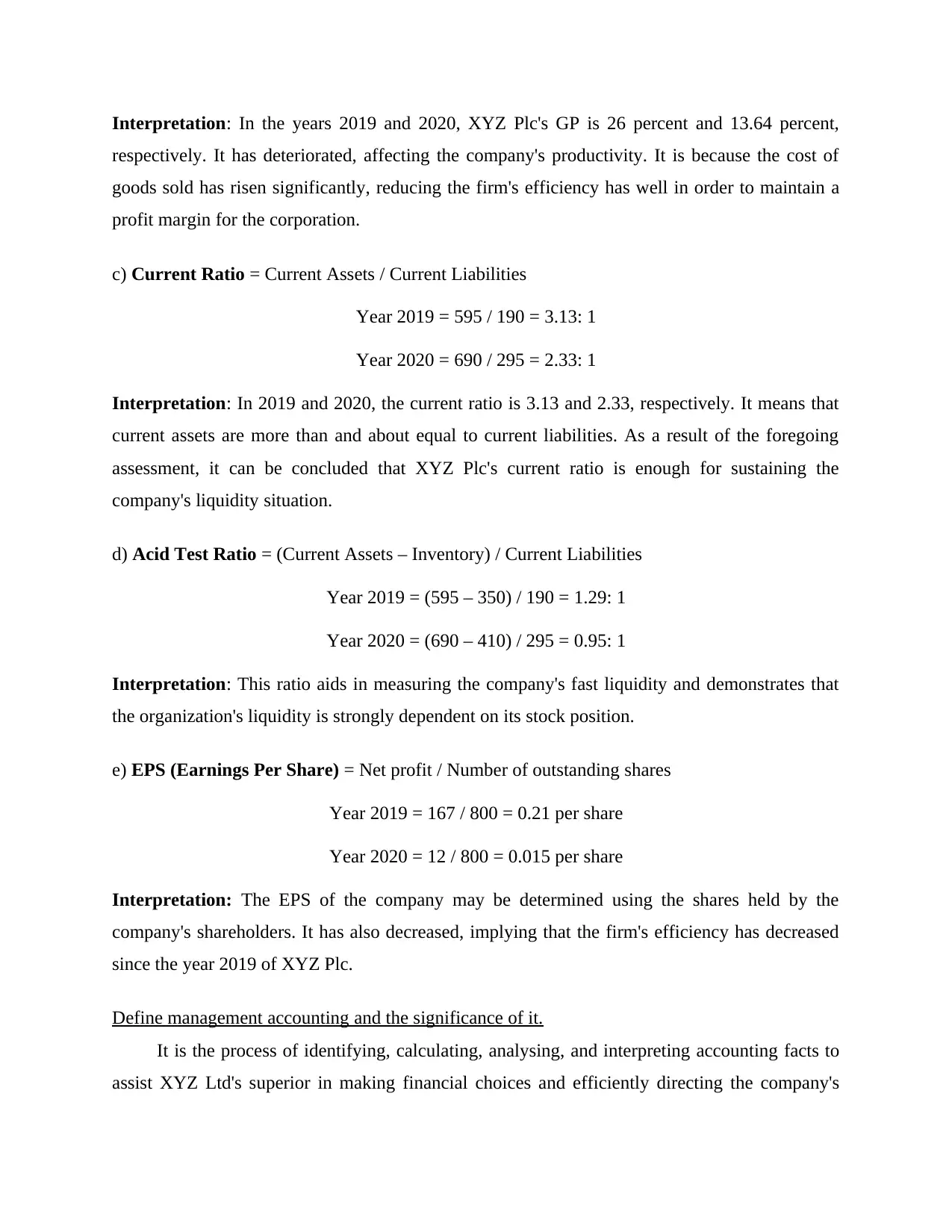
Interpretation: In the years 2019 and 2020, XYZ Plc's GP is 26 percent and 13.64 percent,
respectively. It has deteriorated, affecting the company's productivity. It is because the cost of
goods sold has risen significantly, reducing the firm's efficiency has well in order to maintain a
profit margin for the corporation.
c) Current Ratio = Current Assets / Current Liabilities
Year 2019 = 595 / 190 = 3.13: 1
Year 2020 = 690 / 295 = 2.33: 1
Interpretation: In 2019 and 2020, the current ratio is 3.13 and 2.33, respectively. It means that
current assets are more than and about equal to current liabilities. As a result of the foregoing
assessment, it can be concluded that XYZ Plc's current ratio is enough for sustaining the
company's liquidity situation.
d) Acid Test Ratio = (Current Assets – Inventory) / Current Liabilities
Year 2019 = (595 – 350) / 190 = 1.29: 1
Year 2020 = (690 – 410) / 295 = 0.95: 1
Interpretation: This ratio aids in measuring the company's fast liquidity and demonstrates that
the organization's liquidity is strongly dependent on its stock position.
e) EPS (Earnings Per Share) = Net profit / Number of outstanding shares
Year 2019 = 167 / 800 = 0.21 per share
Year 2020 = 12 / 800 = 0.015 per share
Interpretation: The EPS of the company may be determined using the shares held by the
company's shareholders. It has also decreased, implying that the firm's efficiency has decreased
since the year 2019 of XYZ Plc.
Define management accounting and the significance of it.
It is the process of identifying, calculating, analysing, and interpreting accounting facts to
assist XYZ Ltd's superior in making financial choices and efficiently directing the company's
respectively. It has deteriorated, affecting the company's productivity. It is because the cost of
goods sold has risen significantly, reducing the firm's efficiency has well in order to maintain a
profit margin for the corporation.
c) Current Ratio = Current Assets / Current Liabilities
Year 2019 = 595 / 190 = 3.13: 1
Year 2020 = 690 / 295 = 2.33: 1
Interpretation: In 2019 and 2020, the current ratio is 3.13 and 2.33, respectively. It means that
current assets are more than and about equal to current liabilities. As a result of the foregoing
assessment, it can be concluded that XYZ Plc's current ratio is enough for sustaining the
company's liquidity situation.
d) Acid Test Ratio = (Current Assets – Inventory) / Current Liabilities
Year 2019 = (595 – 350) / 190 = 1.29: 1
Year 2020 = (690 – 410) / 295 = 0.95: 1
Interpretation: This ratio aids in measuring the company's fast liquidity and demonstrates that
the organization's liquidity is strongly dependent on its stock position.
e) EPS (Earnings Per Share) = Net profit / Number of outstanding shares
Year 2019 = 167 / 800 = 0.21 per share
Year 2020 = 12 / 800 = 0.015 per share
Interpretation: The EPS of the company may be determined using the shares held by the
company's shareholders. It has also decreased, implying that the firm's efficiency has decreased
since the year 2019 of XYZ Plc.
Define management accounting and the significance of it.
It is the process of identifying, calculating, analysing, and interpreting accounting facts to
assist XYZ Ltd's superior in making financial choices and efficiently directing the company's
Paraphrase This Document
Need a fresh take? Get an instant paraphrase of this document with our AI Paraphraser
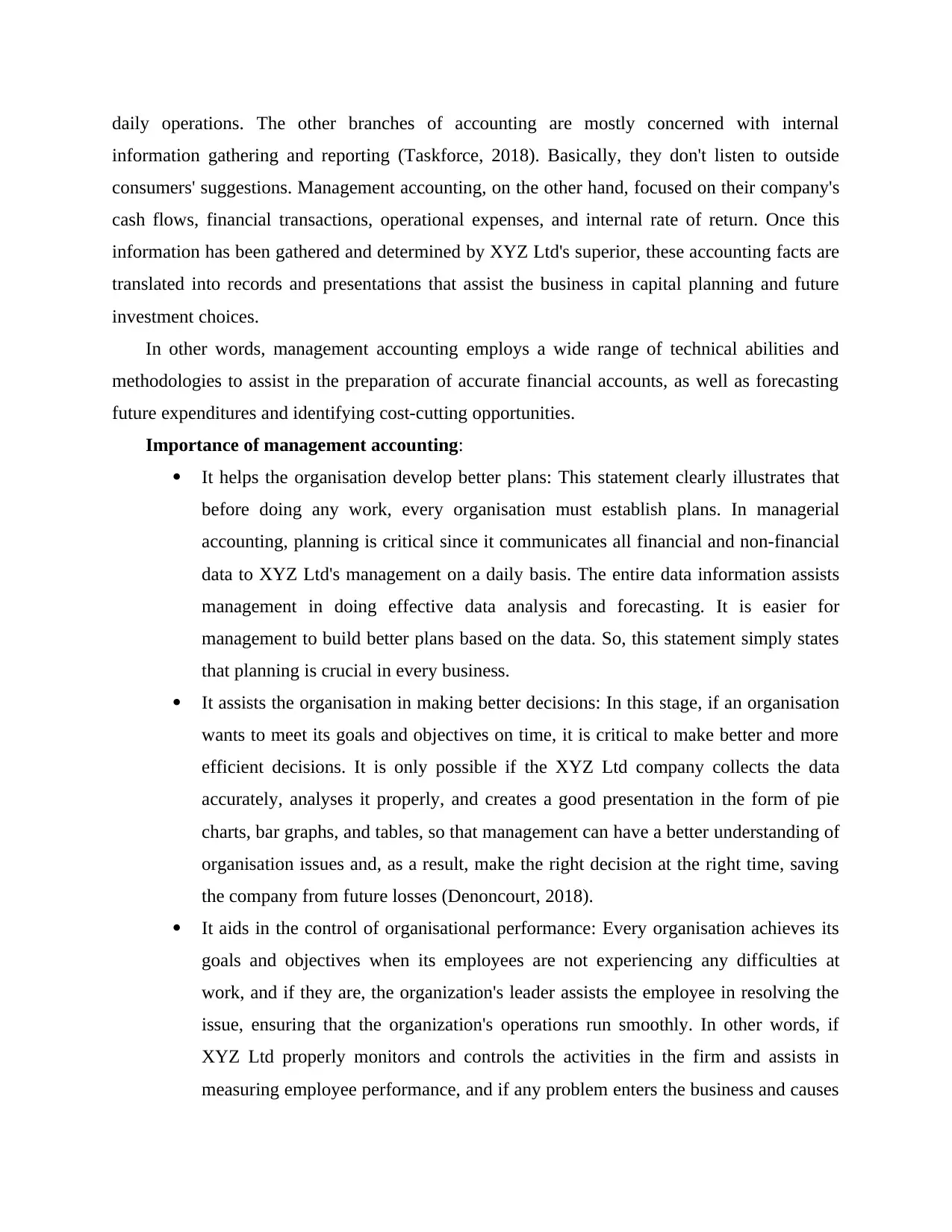
daily operations. The other branches of accounting are mostly concerned with internal
information gathering and reporting (Taskforce, 2018). Basically, they don't listen to outside
consumers' suggestions. Management accounting, on the other hand, focused on their company's
cash flows, financial transactions, operational expenses, and internal rate of return. Once this
information has been gathered and determined by XYZ Ltd's superior, these accounting facts are
translated into records and presentations that assist the business in capital planning and future
investment choices.
In other words, management accounting employs a wide range of technical abilities and
methodologies to assist in the preparation of accurate financial accounts, as well as forecasting
future expenditures and identifying cost-cutting opportunities.
Importance of management accounting:
It helps the organisation develop better plans: This statement clearly illustrates that
before doing any work, every organisation must establish plans. In managerial
accounting, planning is critical since it communicates all financial and non-financial
data to XYZ Ltd's management on a daily basis. The entire data information assists
management in doing effective data analysis and forecasting. It is easier for
management to build better plans based on the data. So, this statement simply states
that planning is crucial in every business.
It assists the organisation in making better decisions: In this stage, if an organisation
wants to meet its goals and objectives on time, it is critical to make better and more
efficient decisions. It is only possible if the XYZ Ltd company collects the data
accurately, analyses it properly, and creates a good presentation in the form of pie
charts, bar graphs, and tables, so that management can have a better understanding of
organisation issues and, as a result, make the right decision at the right time, saving
the company from future losses (Denoncourt, 2018).
It aids in the control of organisational performance: Every organisation achieves its
goals and objectives when its employees are not experiencing any difficulties at
work, and if they are, the organization's leader assists the employee in resolving the
issue, ensuring that the organization's operations run smoothly. In other words, if
XYZ Ltd properly monitors and controls the activities in the firm and assists in
measuring employee performance, and if any problem enters the business and causes
information gathering and reporting (Taskforce, 2018). Basically, they don't listen to outside
consumers' suggestions. Management accounting, on the other hand, focused on their company's
cash flows, financial transactions, operational expenses, and internal rate of return. Once this
information has been gathered and determined by XYZ Ltd's superior, these accounting facts are
translated into records and presentations that assist the business in capital planning and future
investment choices.
In other words, management accounting employs a wide range of technical abilities and
methodologies to assist in the preparation of accurate financial accounts, as well as forecasting
future expenditures and identifying cost-cutting opportunities.
Importance of management accounting:
It helps the organisation develop better plans: This statement clearly illustrates that
before doing any work, every organisation must establish plans. In managerial
accounting, planning is critical since it communicates all financial and non-financial
data to XYZ Ltd's management on a daily basis. The entire data information assists
management in doing effective data analysis and forecasting. It is easier for
management to build better plans based on the data. So, this statement simply states
that planning is crucial in every business.
It assists the organisation in making better decisions: In this stage, if an organisation
wants to meet its goals and objectives on time, it is critical to make better and more
efficient decisions. It is only possible if the XYZ Ltd company collects the data
accurately, analyses it properly, and creates a good presentation in the form of pie
charts, bar graphs, and tables, so that management can have a better understanding of
organisation issues and, as a result, make the right decision at the right time, saving
the company from future losses (Denoncourt, 2018).
It aids in the control of organisational performance: Every organisation achieves its
goals and objectives when its employees are not experiencing any difficulties at
work, and if they are, the organization's leader assists the employee in resolving the
issue, ensuring that the organization's operations run smoothly. In other words, if
XYZ Ltd properly monitors and controls the activities in the firm and assists in
measuring employee performance, and if any problem enters the business and causes
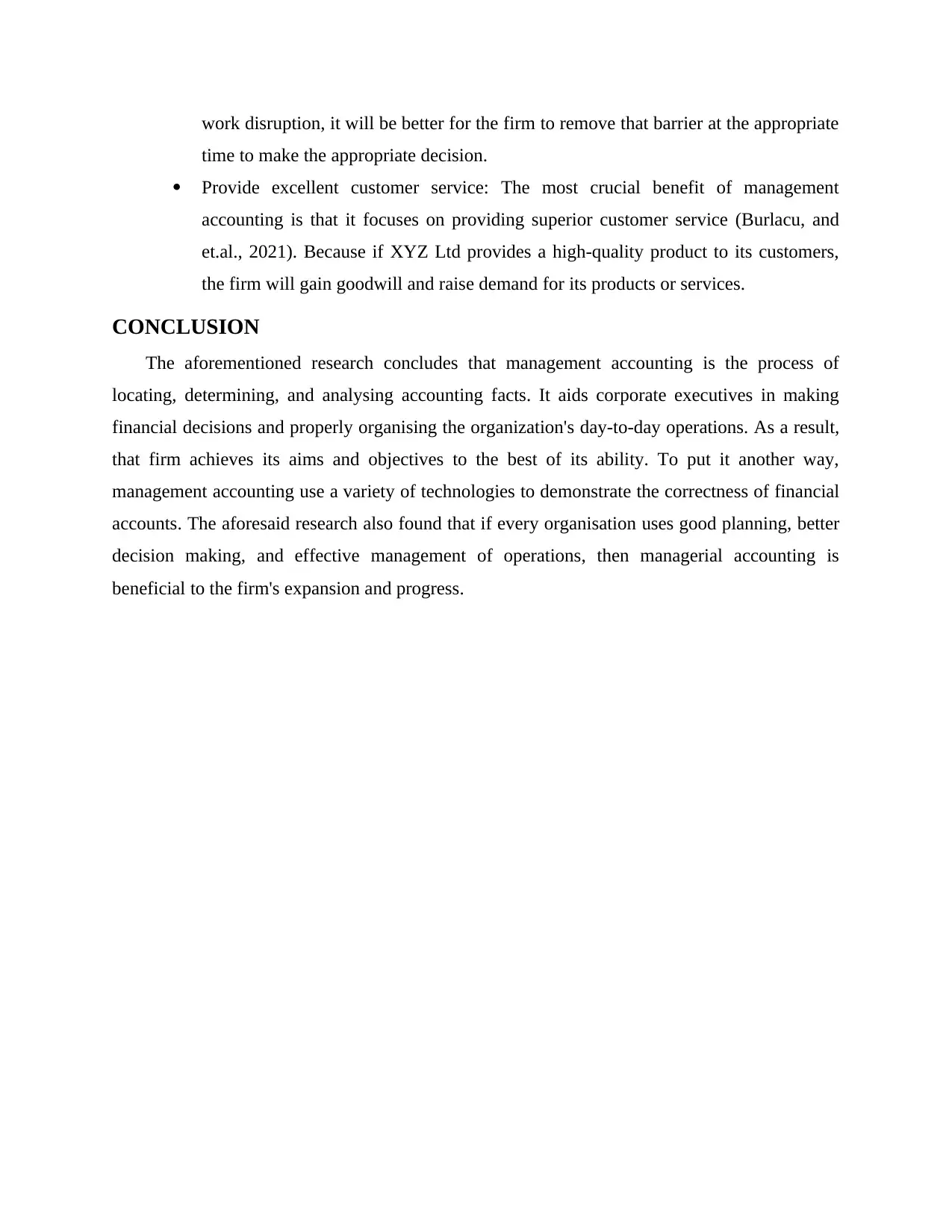
work disruption, it will be better for the firm to remove that barrier at the appropriate
time to make the appropriate decision.
Provide excellent customer service: The most crucial benefit of management
accounting is that it focuses on providing superior customer service (Burlacu, and
et.al., 2021). Because if XYZ Ltd provides a high-quality product to its customers,
the firm will gain goodwill and raise demand for its products or services.
CONCLUSION
The aforementioned research concludes that management accounting is the process of
locating, determining, and analysing accounting facts. It aids corporate executives in making
financial decisions and properly organising the organization's day-to-day operations. As a result,
that firm achieves its aims and objectives to the best of its ability. To put it another way,
management accounting use a variety of technologies to demonstrate the correctness of financial
accounts. The aforesaid research also found that if every organisation uses good planning, better
decision making, and effective management of operations, then managerial accounting is
beneficial to the firm's expansion and progress.
time to make the appropriate decision.
Provide excellent customer service: The most crucial benefit of management
accounting is that it focuses on providing superior customer service (Burlacu, and
et.al., 2021). Because if XYZ Ltd provides a high-quality product to its customers,
the firm will gain goodwill and raise demand for its products or services.
CONCLUSION
The aforementioned research concludes that management accounting is the process of
locating, determining, and analysing accounting facts. It aids corporate executives in making
financial decisions and properly organising the organization's day-to-day operations. As a result,
that firm achieves its aims and objectives to the best of its ability. To put it another way,
management accounting use a variety of technologies to demonstrate the correctness of financial
accounts. The aforesaid research also found that if every organisation uses good planning, better
decision making, and effective management of operations, then managerial accounting is
beneficial to the firm's expansion and progress.
⊘ This is a preview!⊘
Do you want full access?
Subscribe today to unlock all pages.

Trusted by 1+ million students worldwide
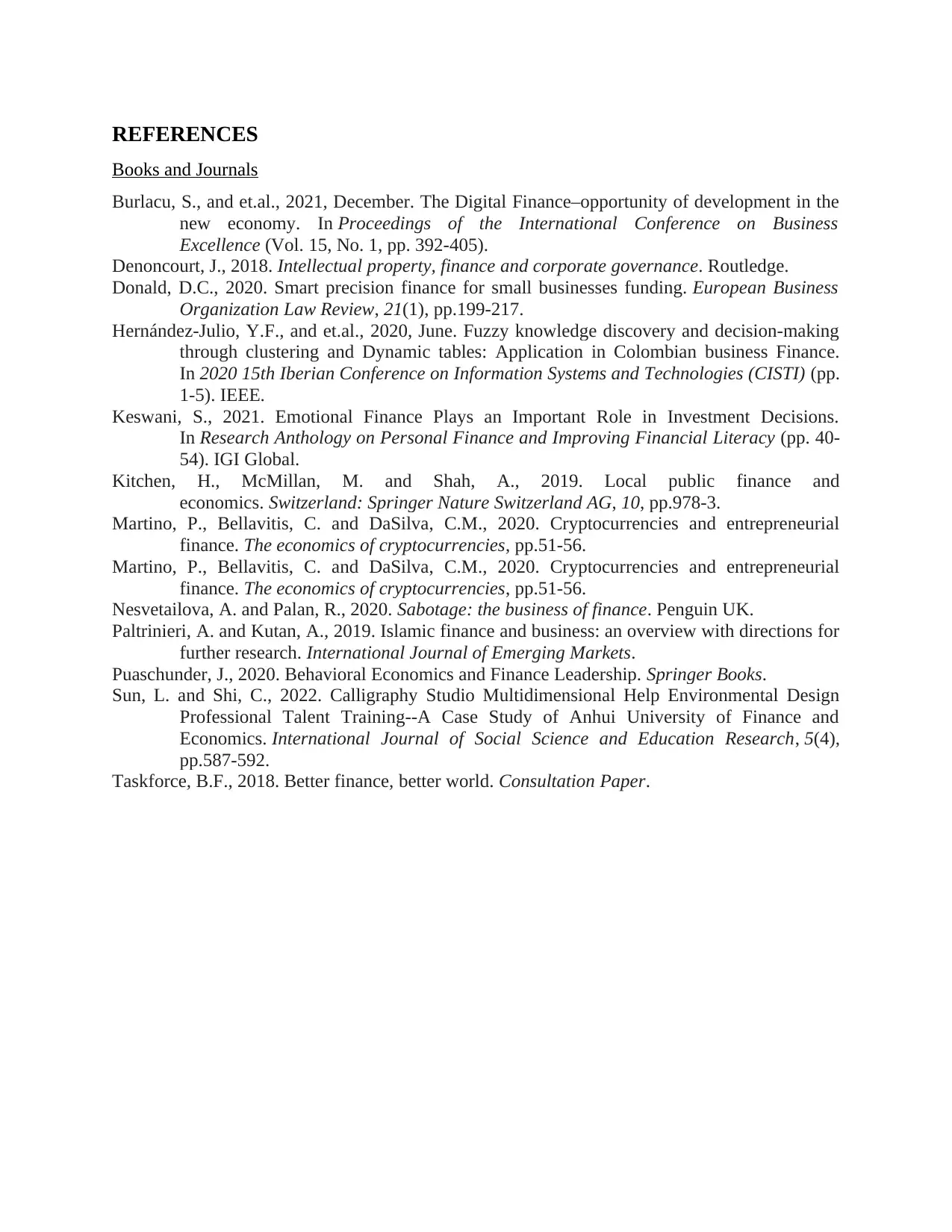
REFERENCES
Books and Journals
Burlacu, S., and et.al., 2021, December. The Digital Finance–opportunity of development in the
new economy. In Proceedings of the International Conference on Business
Excellence (Vol. 15, No. 1, pp. 392-405).
Denoncourt, J., 2018. Intellectual property, finance and corporate governance. Routledge.
Donald, D.C., 2020. Smart precision finance for small businesses funding. European Business
Organization Law Review, 21(1), pp.199-217.
Hernández-Julio, Y.F., and et.al., 2020, June. Fuzzy knowledge discovery and decision-making
through clustering and Dynamic tables: Application in Colombian business Finance.
In 2020 15th Iberian Conference on Information Systems and Technologies (CISTI) (pp.
1-5). IEEE.
Keswani, S., 2021. Emotional Finance Plays an Important Role in Investment Decisions.
In Research Anthology on Personal Finance and Improving Financial Literacy (pp. 40-
54). IGI Global.
Kitchen, H., McMillan, M. and Shah, A., 2019. Local public finance and
economics. Switzerland: Springer Nature Switzerland AG, 10, pp.978-3.
Martino, P., Bellavitis, C. and DaSilva, C.M., 2020. Cryptocurrencies and entrepreneurial
finance. The economics of cryptocurrencies, pp.51-56.
Martino, P., Bellavitis, C. and DaSilva, C.M., 2020. Cryptocurrencies and entrepreneurial
finance. The economics of cryptocurrencies, pp.51-56.
Nesvetailova, A. and Palan, R., 2020. Sabotage: the business of finance. Penguin UK.
Paltrinieri, A. and Kutan, A., 2019. Islamic finance and business: an overview with directions for
further research. International Journal of Emerging Markets.
Puaschunder, J., 2020. Behavioral Economics and Finance Leadership. Springer Books.
Sun, L. and Shi, C., 2022. Calligraphy Studio Multidimensional Help Environmental Design
Professional Talent Training‐‐A Case Study of Anhui University of Finance and
Economics. International Journal of Social Science and Education Research, 5(4),
pp.587-592.
Taskforce, B.F., 2018. Better finance, better world. Consultation Paper.
Books and Journals
Burlacu, S., and et.al., 2021, December. The Digital Finance–opportunity of development in the
new economy. In Proceedings of the International Conference on Business
Excellence (Vol. 15, No. 1, pp. 392-405).
Denoncourt, J., 2018. Intellectual property, finance and corporate governance. Routledge.
Donald, D.C., 2020. Smart precision finance for small businesses funding. European Business
Organization Law Review, 21(1), pp.199-217.
Hernández-Julio, Y.F., and et.al., 2020, June. Fuzzy knowledge discovery and decision-making
through clustering and Dynamic tables: Application in Colombian business Finance.
In 2020 15th Iberian Conference on Information Systems and Technologies (CISTI) (pp.
1-5). IEEE.
Keswani, S., 2021. Emotional Finance Plays an Important Role in Investment Decisions.
In Research Anthology on Personal Finance and Improving Financial Literacy (pp. 40-
54). IGI Global.
Kitchen, H., McMillan, M. and Shah, A., 2019. Local public finance and
economics. Switzerland: Springer Nature Switzerland AG, 10, pp.978-3.
Martino, P., Bellavitis, C. and DaSilva, C.M., 2020. Cryptocurrencies and entrepreneurial
finance. The economics of cryptocurrencies, pp.51-56.
Martino, P., Bellavitis, C. and DaSilva, C.M., 2020. Cryptocurrencies and entrepreneurial
finance. The economics of cryptocurrencies, pp.51-56.
Nesvetailova, A. and Palan, R., 2020. Sabotage: the business of finance. Penguin UK.
Paltrinieri, A. and Kutan, A., 2019. Islamic finance and business: an overview with directions for
further research. International Journal of Emerging Markets.
Puaschunder, J., 2020. Behavioral Economics and Finance Leadership. Springer Books.
Sun, L. and Shi, C., 2022. Calligraphy Studio Multidimensional Help Environmental Design
Professional Talent Training‐‐A Case Study of Anhui University of Finance and
Economics. International Journal of Social Science and Education Research, 5(4),
pp.587-592.
Taskforce, B.F., 2018. Better finance, better world. Consultation Paper.
1 out of 10
Related Documents
Your All-in-One AI-Powered Toolkit for Academic Success.
+13062052269
info@desklib.com
Available 24*7 on WhatsApp / Email
![[object Object]](/_next/static/media/star-bottom.7253800d.svg)
Unlock your academic potential
Copyright © 2020–2025 A2Z Services. All Rights Reserved. Developed and managed by ZUCOL.



